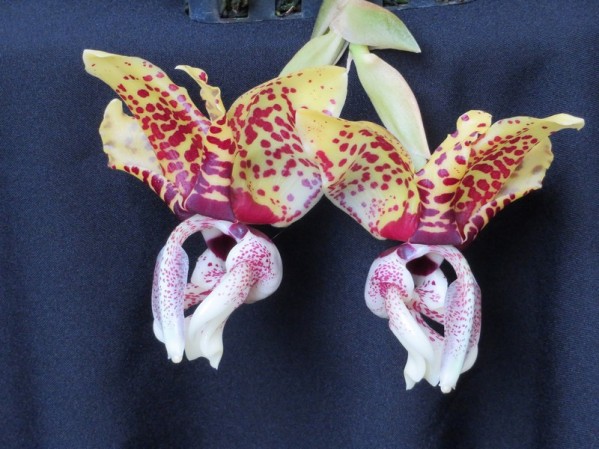By Sandra Simpson
Stanhopea tigrina and Stanhopea nigroviolacea have recently flowered for me – a dramatic event where Triffid-like spikes push through the bottom or side of the basket, grow at a rate of knots and then POP into a complicated and sensationally scented bloom. (Apparently, the buds open with an audible pop at dawn!) Sadly, the magnificent flowers last for only a few days.

Stanhopea tigrina. Photo: Sandra Simpson
There’s some argument as to whether Stan. nigroviolacea is a variety of Stan. tigrina and not a separate plant, but my plants were bought from experienced growers and came labelled differently so I’ll keep it like that until advised otherwise.
Unfortunately, the plants didn’t flower at the same time, although their spikes appeared almost together. The Stan. tigrina spike grew much faster.
This will be my first flowering of Stan. nigroviolacea (bought at the Te Puke show in 2017) and the second of Stan. tigrina (bought at the Tauranga show in 2017), and this year I have two flowers on the spike instead of one.
These orchids are native to Mexico and like to be kept moist, but not wet, and must be grown in a hanging basket to let those amazing flower spikes through – if a spike comes up against an obstacle on its way out of the basket, it will just stop growing so pots are wrong and the wider the slats or wires on baskets, the better.
I’ve repotted one Stanhopea into a basket lined with coconut fibre, a material that holds the potting mix in but is soft enough to let a spike out. One piece of advice I’ve since read is that the basket should be shallow so the spike doesn’t have a long way to travel.
A bit of sphagnum moss in the mix helps moisture retention but the plant’s roots need to dry quickly after watering (yes, contradictory). Give them a drier rest for about a month in winter.

Stanhopea nigroviolacea. This photo gives an idea of the kind of room the spikes need to push through a basket. Photo: Sandra Simpson
I grow mine in a shadehouse (shade cloth sides, opaque roof) in the central city where fans operate almost every day. In summer heat I try and mist plants once or twice a day and in the winter a plastic sheet comes down at the most exposed end.
Conrad has a few at his place (between Katikati and Tauranga) and grows them outside year-round, hanging under trees.
My main fertiliser is Agrisea seaweed pellets which are tucked into the potting mix so the plants get a little feed a little at each watering and – during the hotter months – the baskets get the occasional dunking in a bucket of pre-mixed fertiliser at half-strength.
The Stanhopea Culture website suggests that dividing a plant may mean it won’t flower for anything up to 5 years! And they won’t flower if unhappy – sometimes a move outside into dappled light will initiate a flower spike.
Stanhopea were named in honour of Philip Henry (1781-1855), the 4th Earl Stanhope and president of the London Medico-Botanical Society (half-brother to the adventurer Lady Hester Stanhope). The genus comprises some 50 species with habitats ranging from Mexico to Peru and Brazil.
